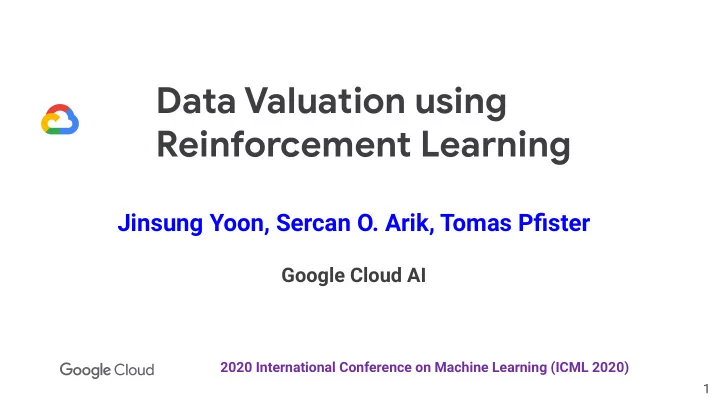

Data Valuation using Reinforcement Learning Jinsung Yoon, Sercan O. Arik, Tomas Pfister Google Cloud AI 2020 International Conference on Machine Learning (ICML 2020) 1
Problem Defjnition What is data valuation? ● ○ How much does each data contribute to the trained model 2 Amirata Ghorbani, James Y. Zou, Data Shapley: Equitable Valuation of Data for Machine Learning , ICML , 2019
Objective & Use-cases - Learn in reliable way Data valuation ● Fair valuation for the labelers and data provider ○ Insights about the dataset ○ 3 Ruoxi Jia et al., Towards Efficient Data Valuation Based on the Shapley Value , AISTATS , 2019
Objective & Use-cases - Learn in reliable way High-value samples Corrupted sample discovery ● Low-value samples 4
Objective & Use-cases - Learn in reliable way Robust learning with noisy (or cheaply-acquired) datasets ● Augmented learning ○ Cheaply-acquired samples High valued samples 5 Amirata Ghorbani, James Y. Zou, Data Shapley: Equitable Valuation of Data for Machine Learning , ICML , 2019
Objective & Use-cases - Learn in reliable way Domain adaptation ● Assigns higher values on the samples from the target distribution ○ Training Set Target Set Type Type A B Type D Type Type C D High valued samples 6
Related works - Leave-one-out Not reasonable when there are two similar training samples. ● 7 Amirata Ghorbani, James Y. Zou, Data Shapley: Equitable Valuation of Data for Machine Learning , ICML , 2019
Related works - Data Shapley Computational complexity is exponential with the number of samples. ● 8 Amirata Ghorbani, James Y. Zou, Data Shapley: Equitable Valuation of Data for Machine Learning , ICML , 2019
Challenges & Motivation ● The search space is extremely large. ○ Impossible to explore the entire space. ● Training processes can be non-differentiable ○ Selection operation (i.e. sampler block) is non-differentiable. ○ Performance metrics can be non-differentiable (accuracy, AUC). End-to-end back-propagation may not be possible. ○ Reinforcement learning is an efficient way to explore large search ● space and to handle non-differentiable process. 9
High-level fjgure for DVRL ● Jointly train selector and predictor in an end-to-end way. 10
Problem formulation To minimize the validation loss Components ● Weighted optimization for ○ Training set: predictor ○ Validation set: ○ Predictor model: ○ Data valuation model: 11
Block diagram 12
Experiments - How to quantitatively evaluate the data valuation? Remove high / low valued samples ● Corrupted sample discovery ● Robust learning with noisy data ● Domain adaptation ● 13
Results - Remove high / low valued samples Standard supervised learning setting (train, validation, test datasets ● come from the same distribution) Remove high valued samples: Fastest performance degradation ● Remove low valued samples: Slowest performance degradation ● 14
Results - Corrupted sample discovery Corrupted sample setting (20% of label noise) ● ● Highest True Positive Rate (TPR) for corrupted sample discovery 15
Results - Robust learning with noisy labels (40%) Proves scalability of DVRL in terms of complex models ● (WideResNet-28-10 and ResNet-32) and large datasets (CIFAR) State-of-the-art robust learning performance ● Mengye Ren et al., Learning to Reweight Examples for Robust Deep Learning , ICML , 2018 16
Results - Domain adaptation on Retail dataset Training Set Train-on-Specific Training Set Testing Set Type D Type Type Train-on-All A B Type D Train-on-Rest Type Type C D Training Set Type A Type Type B C 17
Results - Domain adaptation on Retail dataset Significant gain on Train on Rest setting ( largest domain mismatch ) ● ● Reasonable gain on Train on All setting ( most common setting ) ● Marginal gain on Train on Specific setting ( no domain mismatch ) 18
Results - Domain adaptation in other domains Main source of gain: ● ○ DVRL jointly optimizes the data valuator and corresponding predictor model 19 Amirata Ghorbani, James Y. Zou, Data Shapley: Equitable Valuation of Data for Machine Learning , ICML , 2019
Discussion: How many validation samples are needed? ● A small number of validation samples are enough for DVRL training. Reasonable performances even with 10 validation samples on Adult data. ● 20
Codebase of DVRL DVRL - Github: https://github.com/google-research/google-research/tree/master/dvrl DVRL- AI-Hub: https://aihub.cloud.google.com/u/0/p/products%2Fcb6b588c-1582-4868-a944-dc70ebe61a36 21
Recommend
More recommend